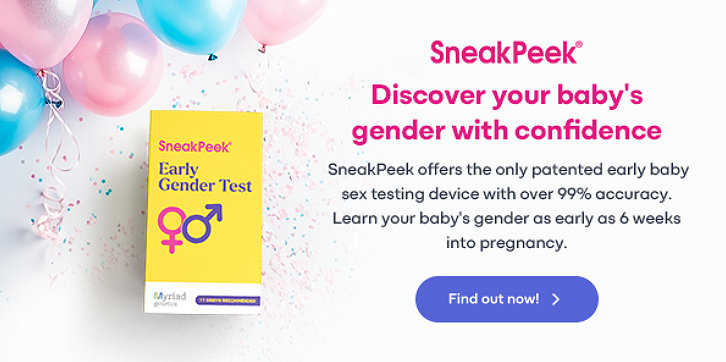Published on August 17th, 2020
Check out SneakPeek Gender Test to find out your baby’s gender as early as 6 weeks with over 99% accuracy!

Do you remember the moments before your pregnancy test read “positive?”
You might have been nervous, uncertain, or hopeful, the only thought in your mind buzzing loud and clear—“Am I pregnant?”
Then, the answer came. And along with the excitement and elation and popping of sparkling cider, more questions sparked in your mind. You’ve probably wondered, “Am I having a boy or a girl?” and considered a gender prediction test to find out before birth.
Two Ways to Know a Baby’s Gender Without an Ultrasound Scan
An ultrasound exam can answer your question, but there’s a catch—you have to wait until you’re about 18 to 22 weeks pregnant to get an ultrasound exam. Let’s face it. That’s too far away.
If you’ve been searching for ways to know the gender earlier than an ultrasound, we have some good news. You don’t have to wait until the middle of your second trimester to find the answer.
There are two accurate, scientifically-proven methods of determining an unborn baby’s gender without an ultrasound scan. They are:
- Healthcare provider-ordered NIPT
- SneakPeek Early Gender Test
This guide will break down how each method of gender determination works and everything else you need to know.
Provider-ordered NIPT
For about nine months, you will share practically everything with your baby from what you breathe to what you eat. At the same time, your baby will also be sharing with you. Throughout your pregnancy, little bits of your baby’s DNA transfer from the placenta into your bloodstream. This type of DNA is called cell-free fetal DNA (cffDNA), and because it’s in your blood, a non-invasive blood test can be used to analyze your baby’s genetics.
This test is known as an NIPT, which stands for Non-Invasive Prenatal Testing. It can also be called prenatal cell-free DNA screening.
So, what is the NIPT test, anyway? In your blood during pregnancy, most of the cell-free DNA (cfDNA) comes from you, but a certain percentage comes from your baby (cffDNA). This percentage is known as the fetal fraction, and it increases the further along you are in your pregnancy. cffDNA are nucleic acid fragments that carry your baby’s genetic blueprint, including information about the chromosomes—like gender. Since your sex chromosomes are XX, if the NIPT test detects Y chromosomal DNA, it indicates your baby is a boy.
But determining gender isn’t the main focus of a provider-ordered NIPT.
The Purpose of a Provider-ordered NIPT
NIPT is a screening for chromosomal abnormalities, such as Down syndrome, Turner syndrome, Edwards Syndrome, etc. It uses statistical analysis to analyze both pregnant person’s and baby’s DNA and report whether the baby has an extra chromosome present (known as a trisomy) or is missing or partially missing one chromosome (known as a monosomy).
To return accurate results, an NIPT requires a pregnant person’s blood to consist of at least 4% cffDNA, which is a 4% fetal fraction. This typically occurs around the 9-12 gestation week mark, which is why a physician has to wait that long to perform an NIPT. However, with some screens like the Prequel® Prenatal Screen, reliable results can be obtained as early as 8 weeks.
Gender Information in NIPTs: Because the NIPT is analyzing baby’s DNA at the chromosomal level, the test can also report on baby’s sex chromosomes, which predicts the gender.
How it Works
Once you’ve talked to your doctor/midwife about why you want an NIPT, you’ll schedule an appointment for the test. A healthcare provider will draw some blood and send it to a lab.
Reasons a Provider Might Order an NIPT
In addition to genetic testing, these tests offer valuable information about the pregnancy and the baby. Your doctor/midwife may recommend an NIPT if…
- You or your partner have a genetic condition that can be determined through an NIPT
- To ease worries and support emotional stability during pregnancy by providing early insights and reassurance
Benefits of NIPT
An NIPT test is an easy and relatively painless way to discover your child’s gender before the second trimester. Additional benefits of an NIPT test include:
- Screening for chromosomal conditions: NIPT can detect common chromosomal abnormalities, such as Down syndrome (trisomy 21), Edwards syndrome (trisomy 18), and Patau syndrome (trisomy 13), with high sensitivity.
- You can learn your baby’s gender early – While not the earliest gender test, an NIPT can tell you the gender of your baby around 12 weeks into pregnancy. However, with some tests like Prequel®, reliable results can be obtained as early as 8 weeks.
- Non-invasive – A needle prick and a little blood is all it takes to learn more about your baby’s genetics.
- Accuracy – When it comes to detecting your child’s gender, the NIPT has an accuracy rate of 98.9%.
- Reduced need for invasive testing: Because of its accuracy and safety, NIPT can reduce the need for invasive procedures like amniocentesis, which carry a small risk of miscarriage.
- Early reassurance: By providing early information about potential genetic risks, NIPT helps expectant parents prepare emotionally and medically.
- Wide accessibility: NIPT is widely available and can be done through your healthcare provider.
Prequel® Prenatal Screen and Foresight® Carrier Screen
If you’re looking for in-depth genetic insights, Prequel® Prenatal Screen and Foresight® Carrier Screen offer valuable options.
- Prequel® Prenatal Screen: This NIPT test offers valuable health insights as early as 8 weeks, giving you peace of mind by identifying risks for chromosomal conditions like Down syndrome. Talk to your healthcare provider about ordering the Prequel screen.
- Foresight® Carrier Screen: A screening test recommended for anyone pregnant or contemplating pregnancy to see if you or your partner are carriers for conditions that could be passed to your child. If you think genetic testing could be helpful, talk to your healthcare provider.
SneakPeek Early Gender Test
If you want to know your baby’s gender as early as possible, you can take the SneakPeek Early Gender Test from the comfort of your home. With just the prick on the arm, you can get to know your future little boy or girl as early as 6 weeks into pregnancy.
What SneakPeek Early Gender Test Can Tell You
The SneakPeek Early Gender Test is a DNA-based blood test that can be taken from home. While it still uses cffDNA, this test isn’t screening for chromosomal abnormalities. It’s only looking for one extra ingredient in pregnant person’s blood—male DNA, or more specifically, a Y chromosome.
- If the test detects a Y chromosome, you’re predicted to have a boy!
- If no Y chromosome is detected, congratulations, you’re predicted to have a girl!
Because this test is only detecting Y chromosomes, not performing statistical analysis to screen for chromosomal abnormalities, the fetal fraction needed is significantly lower.
How it Works
All you have to do is purchase the at-home gender test. Then, follow the instructions to take the test. Once you’re ready, mail back your blood sample using the prepaid label included in your order.
Once your sample is received at the lab, it is tested for the Y chromosome, and your results will be emailed to you within a few days.
And that’s it!
Benefits of SneakPeek Test
The beauty of the SneakPeek Early Gender test is in its simplicity, accuracy, and speediness.
- Find out as early as 6 weeks – Because the test is designed to focus only on fetal sex and return just one answer—male or female—it only needs a small sample and can be taken at just 6 weeks into pregnancy.
- Accuracy – The SneakPeek Early Gender test has an incredible accuracy rate of over 99%, as proven in 9 laboratory studies.1
- Incredibly fast results – You’ll receive your results within days after your sample arrives at SneakPeek Labs.
- Easy to use – Every SneakPeek Early Gender Test kit comes with a clear step-by-step guide and everything you need to take the test.
Find Your Answer Sooner (and Safer) with the SneakPeek Test
Skip waiting for the sonogram and learn more about your child as early as 6 weeks with SneakPeek test. For more information and fun facts about baby gender, check out the blog. You can learn what determines the gender of a baby or confirm if gender cravings or old wives tales are a real thing.
Editorial Policy
At SneakPeek, our commitment is to provide accurate, up-to-date, and reliable information to empower our readers. Our content is thoroughly researched, reviewed by medical experts, and fact-checked to ensure its credibility. We prioritize the well-being and education of our readers, and our editorial policy adheres to the highest standards of integrity and accuracy in all our articles.
This post has been reviewed for accuracy by the following medical professional:
Dr. Heather Soper, Certified Nurse Midwife
Dr. Heather Soper brings over 15 years of experience in women's health and obstetrics to her role as the owner of The Genesis Resort for Birth. Complementing her clinical practice, she serves as an Assistant Professor of Nursing at James Madison University, where she educates nursing students with a focus on compassionate, patient-centered care. Her advanced training and dedication to midwifery are evident in her contribution to both academia and the wellness of expectant mothers
Sources:
Mayo Clinic. Amniocentesis. https://www.mayoclinic.org/tests-procedures/amniocentesis/about/pac-20392914
Medical News Today. What’s to know about amniotic fluid https://www.medicalnewstoday.com/articles/307082#functions
Mount Sinai. Amniocentesis Information. https://www.mountsinai.org/health-library/tests/amniocentesis#:~:text=Results%20of%20genetic%20testing%20usually,Diagnose%20infection
NCBI. Non-invasive prenatal testing: use of cell-free fetal DNA in Down syndrome screening. https://www.ncbi.nlm.nih.gov/pmc/articles/PMC5565870/
Healthline. NIPT (Noninvasive Prenatal Testing): What You Need to Know. https://www.healthline.com/health/pregnancy/nipt-test#what-it-is
US National Library of Medicine. Noninvasive Prenatal Testing: The Future Is Now. https://www.ncbi.nlm.nih.gov/pmc/articles/PMC3893900/
CBS News. Prenatal Testing Leads to Unexpected, Staggering Bills for Some Parents. https://dfw.cbslocal.com/2019/08/15/prenatal-testing-leads-to-unexpected-staggering-bills-for-some-parents/
Norwegian Institute of Public Health. Non-invasive prenatal testing (NIPT) for fetal sex determination. https://www.fhi.no/en/publ/2016/ikke-invasiv-prenatal-testing-nipt-for-kjonnsbestemmelse-av-foster.-metodev/#:~:text=reporting%20this%20outcome.-,Diagnostic%20accuracy%20of%20NIPT%20for%20foetal%20sex%20determination%20is%20very,99.6%25%20and%2098.8%25%20respectively.
WebMD. Pregnancy and Amniocentesis. https://www.webmd.com/baby/pregnancy-amniocentesis#2-5








